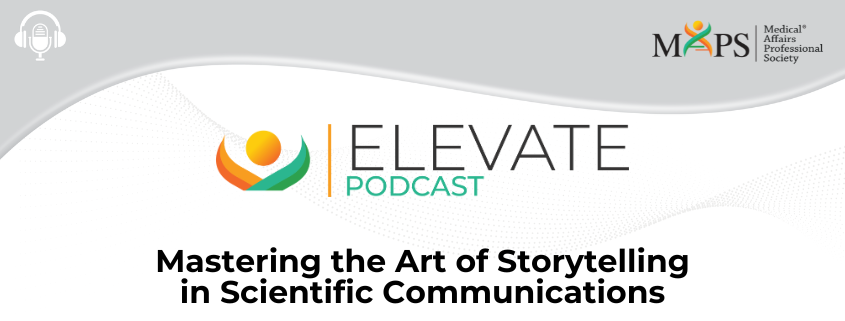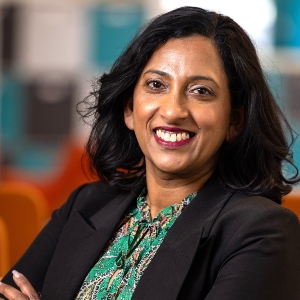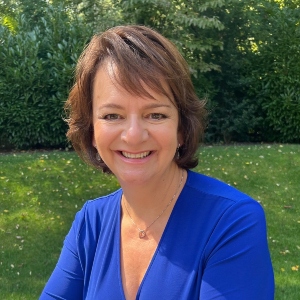In this podcast episode, our experts dive into the importance of storytelling in scientific communication, emphasizing the need to balance creativity with accuracy and personalize content for different audiences.
Speaker: Sissy Easo-Joseph
Speaker: Fatima Ahmad
Speaker: Angie Glover
Speaker: Ezinneka Imoh
Following is an automated transcription provided by otter.ai. Please excuse inaccuracies.
00;00;00;00
MAPS
Oh. Welcome to this episode of the Medical Affairs Professional Society podcast elevate. The views expressed in this recording are those of the individuals, and do not necessarily reflect on the opinions of MAPS or the companies with which they are affiliated. This presentation is for informational purposes only and is not intended as legal or regulatory advice. And now for today’s elevate episode.
00;00;33;09
Sissy Easo-Joseph
Welcome everyone, to mastering the Art of Storytelling in Scientific Communications, in Medical Affairs. I’m your host today, Sissy Easo-Joseph with GSK, I’m here with the fantastic panel to explore something that’s become increasingly important in our world of medical communications. How we bring our science to life through effective storytelling in our scientific communications. Joining me today are two of my fellow Medical Affairs professionals, Ms. Fatima Ahmad from Novo Nordisk, and Ezinneka Imoh from Chiesi, who bring rich real world industry experience and expertise in scientific communications. And we’re also very excited to be joined by Angie Glover, the managing director at connect XL, who brings again, deep expertise in capability building and coaching medical teams on communication skills, storytelling and engagement strategy. Together today, we’re tackling a question that’s been on our minds in a space where every company is sharing data and science. How can differentiation be exhibited when sharing that science? So often it comes down to the story that moments of connection, something that hurts you emotionally or intellectually and makes the science feel relevant, human and engaging. Fatima.
00;02;00;07
Fatima Ahmad
Yes. Thanks. Cc so we all know that the science is foundational. I mean, that’s really our comfort zone, right? But if we’re being honest, we sometimes miss the opportunity to actually tell the story and engage our audience. And that’s why this conversation is so important. Because we want to learn how to bring creativity and strategy together without compromising the science.
00;02;27;22
Ezinneka Imoh
Exactly. Fatima. And today, when I think about, the science of communications landscape, it’s more than just publications. Has gone beyond just MSL. Slide decks. Now we are engaging across different platforms, whether in the digital channels and for graphics, podcast, even use in virtual reality at congresses. Social media. The list goes on and on and on.
00;02;52;24
Sissy Easo-Joseph
So how do we, as Medical Affairs professionals, communicate science in a way that is not only accurate and compliant, but also very meaningful, memorable, and tailored to our audience. That’s what we’re going to explore today in this episode. Let’s dive into how we can transform scientific conversations, help you build trust faster, and elevate your impact as Medical Affairs professionals through scientific storytelling. Now, in this segment, the first segment, what does good look like in scientific storytelling? Angie, you’ve worked with so many medical teams and Medical Affairs professionals in your career, why do you think storytelling is sometimes a challenge in this space?
00;03;40;26
Angie Glover
Well. Thanks. Sissy. It is an interesting challenge. We find the Medical Affairs professionals like yourselves tend to come from clinical practice or research, and are trained to lead with objective evidence and data. The word story can sometimes raise eyebrows, and people worry that it sounds fictional. And storytelling in this scientific data context is about sharing information in a way that connects with others while remaining objective. And that’s critical when you’re aiming to inform or inspire decision making while building your relationships. As you know, we support and develop field teams, MSL payor teams, health system teams, and also headquarters based professionals across the global markets. And the common challenge that we see is that confidence in delivering the science is always high. Yet comfort with shaping that science into a meaningful two way engagement takes work, and that’s why we focus on building narrative skills that respect compliance, while bringing the data to life and making a meaningful connection.
00;04;59;11
Ezinneka Imoh
That really resonates with me. Angie. Thank you. I’ve definitely felt the pressure to get the data rights. Focus on the science. Focus on the endpoints. And oftentimes, we’re told by our compliance colleagues to avoid certain language because it may sound too promotional. And sometimes that is at the expense of that personal human connection that we’re trying to achieve. So, Angie, what do you think helps people shift that mindset?
00;05;26;22
Angie Glover
While this can be a real challenge Ezinneka, so thank you for raising that. We do tend to start by helping teams reflect on their barriers to using narrative, and common themes. We hear are I want to be credible. I don’t want to sound unscientific. I need to be able to demonstrate my expertise. And when we discuss the neuroscience of why stories work, things like neuro coupling, where the brain of the speaker and the listener lights up and the memory recall that you get with an engaging story. People then start to open up to the idea.
00;06;06;18
Sissy Easo-Joseph
And what makes a scientific story good in this context? Angie, I’ve heard so many interpretations over the years.
00;06;13;19
Angie Glover
Well, you’re right CC, there’s so much you can read about scientific storytelling. For me, a good story brings the listener in. It brings the data to life and makes a connection. Can the other person relate to what you’re saying? You need to know your purpose. What’s your why? What are you looking to change in your listeners understanding? Or maybe their behavior? A good scientific story has structure. It has context, and it resonates emotionally, yet still makes sense intellectually. It connects the dots between data and impact. When we’re working with Medical Affairs teams, we often coach them to visualize their communication goal. So before you go in there, before you have that meeting, before you prepare that communication, think about what do you want your listener to know, to think, feel, or do differently as a result? That’s a great place to start.
00;07;17;18
Sissy Easo-Joseph
Thank you. Angie. We’re going to move on to segment two of our podcast now applying storytelling principles to medical communications. How do we balance narrative with science? Let’s talk about how we actually do this in our field. For me, early on, content development for the Medical Affairs team was a bit of a struggle with moving beyond that traditional slide deck need for data and science, and small or large slide decks without a story for why, how, or where the data fits with our strategy. Or more importantly, how does the story bring patient centricity to the forefront? How do you help teams with this energy?
00;08;00;14
Angie Glover
Well, as you see, this is a great again, a really super question to think about. How do we start this off with a team? And we often start with a scientific engagement framework. And many teams that we work with have a model already. And if not, we’ll bring a simple framework to help them with the skills of planning, engaging and following up their interactions both externally with HCP and Kols and internally with their key stakeholders. The first step is about making a connection and building rapport with the other person or the group. To help with this, we often share a really simple structure to plan the building blocks of an engaging opening, and I’d love to thank my good friend Kathy Nichols for sharing this approach with me many, many years ago. It’s a very simple ABCd, so A is for attention. What’s your hook? What will grab that interest in the first 10s? This could be a compelling question, an unexpected insight, or maybe a patient story that relates to the data you’re about to share. B it’s the benefit or belief. Why should they care? This is about connecting to what matters to your audience. Maybe it’s clinical impact. Maybe it’s an operational improvement, a new insight that helps them help their patients see is the credibility. Why should they trust you? The credibility might come from your own background and experience, your company’s expertise, a specific trial you worked on, or even your motivation for doing this role. D is for direction or do differently. Where is this going? What should happen next? What are you hoping that they take away after engaging with you? The great thing is these don’t necessarily have to be in that order. It’s just that having all four helps build a solid and meaningful opening. Once you’ve established that the rest of the discussion can flow more naturally into dialog.
00;10;16;26
Sissy Easo-Joseph
Thank you. Angie. I really love that ABCd. It really gives a great guide for us to follow in creating a really wonderful story. For us to really present that content and really drive what we want to say in a really creative way. Fatima, how do you engage your audiences from the get go from that beginning?
00;10;38;12
Fatima Ahmad
Yeah. CC great question. So I’m going to now loosely apply the ABCd in answering the question. So when you say how do you grab the audience? I found that opening with a human insight can really help, take the audience’s attention. Sometimes is you know, our clinical audiences can be very data driven and they’re waiting for the data, but, there is a lack of human connection. So, for example, if we’re talking about the scientific narrative and we’re going to be talking about clinical studies, maybe a more compelling approach would be to start with the unmet need. Again, I’m talking about the attention and and now coming to the B for benefit or belief. So you know, talk about the unmet need there. And start from the patient experience. So for example in rare diseases, there are so far and few treatments for such conditions that walking the audience first through the patient experience or the patient journey, first of all, is the B for belief. And it’s also establishes your credibility because you’re demonstrating that this is something you’ve looked at deeply and that you’re putting it into the context for the scientific narrative. And that for a patient with a given rare disease, for example, who are unable to do activities of daily living, things that really impact their quality of life, things that we take for granted every day. And they these may be just a remote possibility for these patients. So engaging. This is an example, right. So just engaging in, in this type of a structure really helps cement the scientific narrative and ensures that your audience’s attention is where you want it to be. And then for D for do something different, this is where you might even give a specific example of a patient living with a rare disease and, how their experience has shaped their journey.
00;12;39;25
Angie Glover
I love that, Fatima. Thank you for sharing a patient experience. Demonstrating you need is a great way to grab attention. If you’re new to storytelling, though, it could be helpful to practice with a mini personal story. So saying something like. Before moving into this role, I should ordered similar patients in this field, or my research was in X, which is why I feel so passionately about what we can do to help these patients. Phrases like this can help establish your credibility and show that you care. We often underestimate the impact of relatability. Being real earns trust and builds relationships. What do you think? Ezinneka?
00;13;24;10
Ezinneka Imoh
I agree, Angie. It is super important when dealing with stakeholders who may see things purely for a digital lens. Like Angie and Fatima mentioned, it’s important to start with the human element because stories about people create emotional resonance. It’s also important to stay grounded in the science and the data. I’ve also found it particularly important to use clear, accurate scientific language and to avoid any jargon.
00;13;55;06
Sissy Easo-Joseph
Thank you. That leads us right into our third segment for the podcast, demonstrating value through personalization. And I hand it over to Fatima to lead us in this discussion.
00;14;07;03
Fatima Ahmad
Yeah. Thanks. See, I think we’ve, really laid the groundwork, so far into how we personalize the scientific narrative. And this is really close to my heart. So when we, especially within rare diseases, where is an area that I’ve worked in for a number of years, the patient B based or humanistic factor is really critical. So for example, how I would engage and speak with a community HCP would be very different from how I speak to the pharmacist or a specialist, depending upon where in their, journey they might meet the patient. So I’ve learned this the hard way that if I don’t personalize the message that I’m trying to give based on the audience, then my message is not going to resonate. So one example that I can really share, where, you know, it really brought home to me how deeply, a patient experience can impact someone, i.e. your physician is that I was attending a patient segment where there was a family with their little boy who suffered from a very rare genetic disease, which caused eyesight loss. And so during the course of the panel, you know, we’re talking to the patients where, you know, the little boy is sitting there, and then he suddenly jumps up and he runs across the stage, and goes to the window. It was wintertime. It was January, and it was just starting to snow. And we realized that at that point, his both his parents told us that this is the first time that he’s seeing snow ever in his life. This and this is after receiving the treatment that had restored his sight. And, you know, this is something that we take for granted every day. You know, being able the ability to talk, walk, see, hear. And he had been receiving this therapy for his rare disease, which had really enabled him, to enjoy things that we enjoy on a daily basis. So, you know, it really hit me. It was a very emotional moment. So when you speak to physicians who are general pediatricians, you know, they may not realize the impact, of, a treatment on a patient or they, they may, but because they may have never met a patient like that, these are rare patients. For example, you have to tell the story in a way that would resonate with them. And, and so this is something that I’ve learned over, over the course of my career. And I now try to bring it through into, developing scientific narrative.
00;16;44;16
Sissy Easo-Joseph
Thank you for Tamara. Yes. I think we can call that shared starting point. An overarching narrative. A kind of our North Star. It truly gives us a consistent foundation. And it is not one size fits all. A conversation with a pharmacist, for example, might draw out different perspectives than than a discussion with a nurse practitioner or even a primary care physician or a specialist, for example. We’re always asking, how can we customize that story to meet the needs of our specific audience? Angie.
00;17;17;22
Angie Glover
Absolutely. The core story stays the same, and the emphasis shifts. Like we said, CC, a Cal might want the data and a nurse practitioner might need patient relevance. A payer might want real world impact. So when we’re thinking about this, we help teams build the shared narrative by agreeing the key communication points that align the medical strategy, and then encouraging each individual to bring their own authentic voice to it, helping them practice different adaptations and approaches so that the whole team then learns from each other.
00;17;57;25
Sissy Easo-Joseph
And that tailoring is a communication storytelling skill. I remember seeing a colleague reframe the same story in three different ways, depending on the audience, and it completely changed the dynamic and the way we told the story based on that audience. Whether it was a specialist. Again, primary care or payer. We do need to tweak that story depending on who we are speaking to.
00;18;23;19
Angie Glover
Absolutely. And it’s important to support teams to build comfort and confidence in flex in that communication. For example, when we work with field teams, they learn so much from each other by practicing and sharing different takes on the same data. That’s how we build agility and the ability to adapt that communication to the situation and the audience.
00;18;48;10
Fatima Ahmad
Yeah. And Susie, you mentioned that. You know, this is about tailoring. And tailoring is a skill. So now you have the attention of your HCP, your audience. You’re delivering your scientific narrative. They understand the unmet need. They understand the patient journey. But you have to continue to tailor the communication. So now you’re coming to the point. Well, what does it mean for them? Sometimes and especially again, I’m referring, to rare disease but in other therapeutic areas as well. It’s a collaboration between two specialties. Or it might be a collaboration between a pediatric specialist and an adult specialist. And they may encounter the patient at different parts of the treatment journey. And so or they may carry out part of the treatment. And then it has to transition to the other specialty. So you would not tell or deliver that scientific narrative in the same way to both these, different audiences. You would continue to tailor so that they know what’s relevant for them. So it’s not always only about the hook. Obviously, you do want to have the humanistic piece, you want to have that context, but then you have to make sure to pull it through right to the very end and make sure that you’re communicating what’s relevant, based on your audience’s needs and their and their place in the treatment journey.
00;20;16;29
Sissy Easo-Joseph
Thank you. Fatima. And that brings us to our segment four of the podcast, Why Stories Matter in Scientific Communications. It’s really encouraging and reassuring that our end goal clearly, is to impact the lives of patients. That is why we do what we do. A constant reminder that we’re not just communicating data and science. We are creating clarity, confidence, and even hope. And I think that’s something we all need to remember more often when we are creating scientific content.
00;20;50;23
Angie Glover
That’s true. And in today’s Medical Affairs landscape, relationships matter more than ever. If we look back to when I started in the pharma industry many years ago, and there was no such thing as field medical, Medical Affairs was an office function. And unless you were a renowned expert, any in Excel interaction was often a one and done. And times have changed so much. The ongoing evolution of Medical Affairs from being the scientific expert to a strategic partner, means that having excellent communication skills is no longer optional. We help teams move from transactional data delivery to relationship building and dialog. That shift is what creates long term value. We often say to field teams, the goal of your first visit is to get a second one and then build relationships over time to be seen as a partner of choice for that physician, for that health care provider. And that takes trust, which storytelling helps them.
00;22;04;06
Ezinneka Imoh
Yes, Angie. That’s exactly what it comes down to. You know, holding your agenda lightly. Staying curious and also making space for what the other person values. I’ve seen this mindset completely shift the outcome of a conversation. For example, when engaging with a new will, he or she may not always want to hear everything about your company or your pipeline, or your recent phase three data readout solely. It’s important to make space to learn about the skills research interests. Any practice patterns. Any current gaps in health care, barriers he or she may be facing, and so on. And even to learn about the killer’s personal interests. It’s not always one sided. It should not be one sided. It should be mutually beneficial relationship while keeping patients at the forefront.
00;22;54;29
Fatima Ahmad
And because when we do that, we don’t just hit our metrics. We make an impact in a really meaningful way.
00;23;01;15
Sissy Easo-Joseph
Thank you. Angie. Fatima has a knack for such an insightful, inspiring conversation. And thank you to our listeners for joining us and learning a bit more about mastering the art of storytelling and scientific communications. If you just took one one item away, one learning away from today, we hope it’s this great. Communication isn’t just about simplifying the science and the data, it’s about making science meaningful, memorable, and impactful by telling a great story. A huge thanks to our guests and our podcast team again, Angie Glover, Fatima Ahmad, and Ezinneka, along with Elise Blankenship, who was instrumental in creating the podcast content for you. Until next time, continue to change the lives of patients by having no limits. The art of the possible in scientific communications is telling a compelling scientific story.







